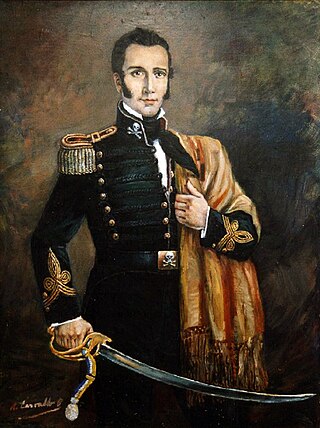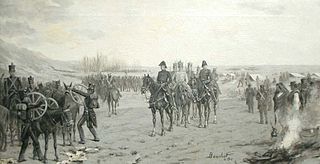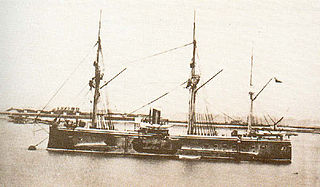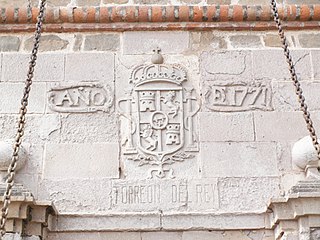
José Francisco de San Martín y Matorras, nicknamed "the Liberator of Argentina, Chile and Peru", was an Argentine general and the primary leader of the southern and central parts of South America's successful struggle for independence from the Spanish Empire who served as the Protector of Peru. Born in Yapeyú, Corrientes, in modern-day Argentina, he left the Viceroyalty of the Río de la Plata at the early age of seven to study in Málaga, Spain.

The Argentine War of Independence was a secessionist civil war fought from 1810 to 1818 by Argentine patriotic forces under Manuel Belgrano, Juan José Castelli, Martin Miguel de Guemes and José de San Martín against royalist forces loyal to the Spanish crown. On July 9, 1816, an assembly met in San Miguel de Tucumán, declaring independence with provisions for a national constitution.

Manuel José Blanco y Calvo de Encalada was a vice-admiral in the Chilean Navy, a political figure, and Chile's first President (Provisional) (1826).

The Battle of Maipú was fought near Santiago, Chile on 5 April 1818, between South American rebels and Spanish royalists, during the Chilean War of Independence. The Patriot rebels led by Argentine general José de San Martín effectively destroyed the Spanish forces commanded by General Mariano Osorio, and completed the independence of the core area of Chile from Spanish domination.

Manuel Xavier Rodríguez Erdoíza was a Chilean lawyer and guerrilla leader, considered one of the founders of independent Chile. Rodríguez was of Basque descent.

The Battle of Cancha Rayada, was fought in Chile between South American patriots and Spanish royalists, during the Osorio's campaign in the South American wars of independence. The result was a defeat for the patriot forces, weeks later the patriots take their rematch at the Battle of Maipú.

The Chilean War of Independence was a military and political event that allowed the emancipation of Chile from the Spanish Monarchy, ending the colonial period and initiating the formation of an independent republic.

The Army of the Andes was a military force created by the United Provinces of the Río de la Plata (Argentina) and assembled by General José de San Martín as part of his campaign to liberate Chile from the Spanish Empire. In 1817, it crossed the Andes Mountains from the Argentine province of Cuyo and succeeded in its objective by driving the Spanish out of Chile.

Pedro Blanco Soto was a Bolivian soldier and politician and president of the Republic of Upper Peru, an unrecognized entity that emerged in the limits of the department of La Paz and, which claimed the territory of the Republic of Bolivia. He held the position for a short time before being killed by his opponents in a convent called La Recoletta in Sucre on New Year's Day 1829. A small plaque now marks the spot in the Museo de la Recoletta. He was well known for his pro-Peruvian stance and this is generally the reason attributed to his assassination. He was also a distinguished officer during the Peruvian War of Independence.

Ventura Blanco y Calvo de Encalada was a Chilean political figure.

Events from the year 1814 in Chile

The Army of the North, contemporaneously called Army of Peru, was one of the armies deployed by the United Provinces of the Río de la Plata in the Spanish American wars of independence. Its objective was freeing the Argentine Northwest and the Upper Peru from the royalist troops of the Spanish Empire. It was headed by Hipólito Vieytes (1810), Juan José Castelli (1810–1811), Juan Martín de Pueyrredón (1811–1812), Manuel Belgrano (1812–1814), José de San Martín (1814), José Rondeau (1814–1816), Manuel Belgrano (1816–1819) and Francisco Fernández de la Cruz (1819–1820).

Blanco Encalada was a central battery ship built by Earle's Shipbuilding Co. in England for the Chilean Navy in 1875. She was nicknamed El Blanco. She participated actively in the War of the Pacific, her most important action being the capture of the Peruvian monitor Huáscar during the Battle of Angamos.

The Hussars of Death were a paramilitary group founded by Chilean guerrilla Manuel Rodríguez Erdoíza after the Second Battle of Cancha Rayada, on March 23, 1818.

The First Chilean Navy Squadron was the heterogeneous naval force that terminated Spanish colonial rule in the Pacific and protagonized the most important naval actions of in the Latin American wars of independence. The Chilean revolutionary government organized the squadron in order to carry the war to the Viceroyalty of Perú, then the center of Spanish power in South America, and thus secure the independence of Chile and Argentina.
Cancha Rayada is a plain in the north of the city of Talca in Central Chile. Before urbanization the place was in the outskirts of the city. Cancha Rayada is bounded to north and west by Claro River. Cancha Rayada is best known for being the location of two important battles in the Chilean War of Independence, in 1814 and 1818, both of them royalist victories.
The following lists events that happened during 1818 in Chile.

The second siege of Callao was the longest lasting siege that occurred on the Pacific coast during the Spanish American wars of independence. The siege was carried out by the combined Gran Colombian and Peruvian independence forces against the royalist soldiers defending the Real Felipe Fortress in the port of Callao, who refused to surrender, and refused to accept the capitulation of the Battle of Ayacucho.
Battle of Pudeto was an attack by Chilean patriot forces during the 1826 campaign on the Spanish stronghold of Chiloé in southern Chile.

The Callao uprising, also known as the Callao mutiny, took place on February 5, 1824, in the Real Felipe Fortress in Callao, during the campaigns of Simón Bolívar in the Peruvian War of Independence, when Chilean, Colombian, Peruvian and Argentine units of the Army of the Andes rose up and crossed to the Spanish side, ending the unit's existence.
















